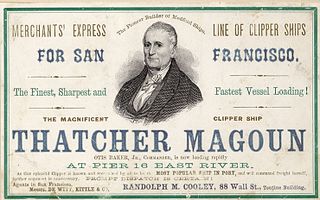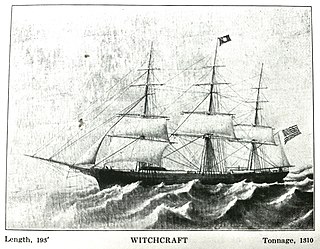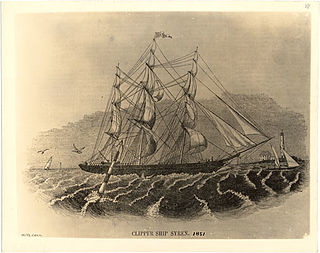
Flying Cloud was a clipper ship that set the world's sailing record for the fastest passage between New York and San Francisco, 89 days 8 hours. The ship held this record for over 130 years, from 1854 to 1989.

Hallowe’en was a 920-ton iron clipper ship. She was built in 1870 by Maudslay, Son & Field at Greenwich, England, for Jock Willis & Sons, and was a sister ship to the clipper ship Blackadder.

When launched in 1853, Great Republic was the largest wooden ship in the world. She shared this title with another American-built ship, the steamship Adriatic. She was also the largest full-rigged ship ever built in the United States. She was built by Donald McKay for trade on his own account to Australia.

Sovereign of the Seas, a clipper ship built in 1852, was a sailing vessel notable for setting the world record for the fastest sailing ship, with a speed of 22 knots (41 km/h).

Surprise was a California clipper built in East Boston in 1850. It initially rounded Cape Horn to California, but the vessel's owners, A. A. Low & Brother, soon found that the vessel performed well in Far Eastern waters. From that point onward the vessel spent much of her working life in the China trade, although the vessel also made three trips from the East Coast of the United States to California.

The Thatcher Magoun, an extreme clipper launched in 1855, was named after Medford's great shipbuilder, Thatcher Magoun, who died the year that she was launched.

Witchcraft was a clipper built in 1850 for the California and China trade. She made record passages from Rio de Janeiro to San Francisco, and from San Francisco to Callao, Peru.

Herald of the Morning was one of the few clipper ships with a passage to San Francisco in less than 100 days.

The Memnon was the first clipper ship to arrive in San Francisco after the Gold Rush, and the only clipper to arrive in San Francisco before 1850. Built in 1848, she made record passages to San Francisco and to China, and sailed in the first clipper race around Cape Horn.

Hornet was an 1851 extreme clipper in the San Francisco trade, famous for its race with Flying Cloud.

Lookout was an 1853 clipper known for her passages from New York to San Francisco, and as an offshore and coastal trader in the lumber and coal trades.

Witch of the Wave was a long-lived extreme clipper in the California trade, with a sailing life of over 34 years. In 1851, she sailed from Calcutta to Boston in 81 days, setting a record. It was renamed the Electra in 1871.

Comet was an 1851 California clipper built by William H. Webb which sailed in the Australia trade and the tea trade. This extreme clipper was very fast. She had record passages on two different routes: New York City to San Francisco, and Liverpool to Hong Kong, and beat the famous clipper Flying Dutchman in an 1853 race around the Horn to San Francisco.

Syren was the longest lived of all the clipper ships, with a sailing life of 68 years 7 months. She sailed in the San Francisco trade, in the Far East, and transported whaling products from Hawaii and the Arctic to New Bedford.

Cimba was a British-built clipper in the Australian wool trade. She sailed between London and Sydney for 20 years, from 1878 to 1898. In 1905, Cimba set the sailing ship record for a passage from Callao to Iquique, of 14 days.

Shooting Star was an extreme clipper built in 1851 near Boston, in Medford, Massachusetts. She was the first "real clipper" to be built in Medford, and sailed in the San Francisco, China, and Far East trades. According to Howe and Matthews, she was known as "one of the fastest of the small clippers".

Starlight was a medium clipper built in 1854 in South Boston, Massachusetts that made nine passages from New York City or Boston to San Francisco. The ship was known in its day for "making passages faster than average". Starlight is better remembered today as the subject of two paintings by artist Fitz Hugh Lane. Starlight was described as having "spacious staterooms" and a figurehead resembling "the representation of an antediluvian bird of Paradise spliced into a mermaid".

Bald Eagle was a clipper ship launched in 1852 which made four round-trip passages from eastern U.S. ports before being lost on her fifth voyage in the Pacific ocean in 1861. She set the record, 78 days 22 hours, for the fastest passage of a fully loaded ship between San Francisco and New York.

Glory of the Seas was a medium clipper ship launched in 1869. She was the last merchant sailing vessel built by Donald McKay.























